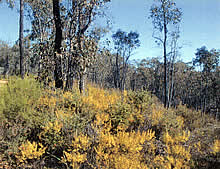Goldfields Revegetation
Managing Your Bush Block
Why have you chosen to buy a bush block? You probably chose it because
you appreciate the beauty of our natural environment and wish to
live in harmony with the flora and fauna of the Bendigo bush.

But living in a Box-Ironbark Forest or other Australian native bushland
is not for everyone. For those who appreciate natural surroundings,
with native flora and fauna, it can provide a very rewarding lifestyle.
On the other hand, if someone is afraid of the bush, whether for
bushfire, snakes or some other reason, then perhaps they should buy a cleared
block. Someone who clears their bush block from a fear of fire,
is spoiling the environment for their neighbours, who chose to live
in a bush area
The indigenous vegetation of Central Victoria is called Box-Ironbark
Forest, named after the principal eucalypt species, Grey Box, Yellow
Box, Red Ironbark and so on.
In detail, a number of subdivisions
are recognised, corresponding to different soil and drainage
conditions. For example dry rocky ridges carry Grey Box and Red Stringybark,
while Yellow Box is largely confined to alluvial soils along
creeks
and rivers.
Box-lronbark Forest exists only in Central Victoria and a small
adjacent area in southern New South Wales.
It is found nowhere else in the world, but in the past 150 years
we have cleared 85 per cent of it. Therefore we must minimise the
impact of our activities on the remaining forest and use indigenous
species in our revegetation work. This will be of great benefit in
arresting the decline and helping to restore this important forest
type.
 Indigenous species are plants or animals that have evolved in the
area, as opposed to species brought in from elsewhere, which are
termed exotic. In Victoria, 'exotic’ applies equally to plants
from Western Australia as to those from Europe. Indigenous species are plants or animals that have evolved in the
area, as opposed to species brought in from elsewhere, which are
termed exotic. In Victoria, 'exotic’ applies equally to plants
from Western Australia as to those from Europe.
Indigenous vegetation has evolved to suit the local soil and climate
and, importantly, in association with the local fauna. It therefore
provides the ideal food and habitat for the local fauna and some
plant species may even use the birds and animals as agents for distributing
seeds.
The use of indigenous species helps maintain (or even restore)
biodiversity. Biodiversity means the range of different plant and
animal species, a feature of natural systems that has been greatly
reduced since the European settlement of Australia.
Your block may be small in area, but it can provide valuable habitat
for native fauna and, in combination with like-minded neighbours,
can form part of a wildlife corridor, helping the preservation of
our wildlife.
Some points to help you to manage your bush block:
- Take time to study your block in
every season as this will help you to appreciate the diversity
of species. It is helpful
to
do this before building if time permits.
- Do not bring in commercial topsoil.
It tends to contain weed seeds and is high in plant nutrients;
both factors are bad
for native
plants and will cause problems.
- Do not water the bush. Our indigenous
species have evolved to suit the climate and, once established,
do not require regular
watering.
- Septic tank effluent is too high
in nutrients for native plants. This, combined with the extra
water, will eventually
kill many species, including Box and Ironbark trees.
- Environmental weeds are a serious
problem in many Victorian regions. Familiarise yourself with
their identification and eradicate
any you find. Unfortunately, many of them are still sold by commercial
nurseries.
- Planting of indigenous species
should be confined to the cooler months. Planting in summer will
result in many losses.
Rabbit guarding is likely to be needed in most areas.
- Dogs and cats can be very destructive
of native wildlife. If you have pets, ensure they are adequately
controlled.
- Clearing for house sites
and so on should minimise the destruction of mature trees – they
are quite rare around Central Victoria, where most trees are
regrowth, less than 100 years old.
- Dead trees, logs and rocks should
be retained as far as possible, because they are valuable habitat
for birds, reptiles
and insects.
- Excavation for underground services
requires care. Push aside the litter layer, then the topsoil,
before digging the trench,
preferably
using a ditch-witch. After backfilling, return the topsoil and
litter. This way disturbance is managed and the land will virtually
heal
itself.
- Dams are commonly required on larger
bush blocks. Preserve the litter layer and topsoil during excavation,
so it can be
used to cover the batters of the embankment. The latter should
be vegetated
to prevent erosion, but should be kept free from trees and large
shrubs, whose roots can weaken it.
- Subsoil from dam excavation is
a suitable rooting medium for indigenous species and may be used
for garden beds or similar
purposes.
- Rabbits are always potential invaders
of your property, if not already present. Do not provide them
with habitat, such
as piles of loose soil, timber or rubbish.
- Fire is always a risk in bush areas.
Take sensible precautions such as
avoiding trees and large shrubs close to the house, cutting long
grass and
keeping woodpiles and other hazards at a suitable distance.
|




